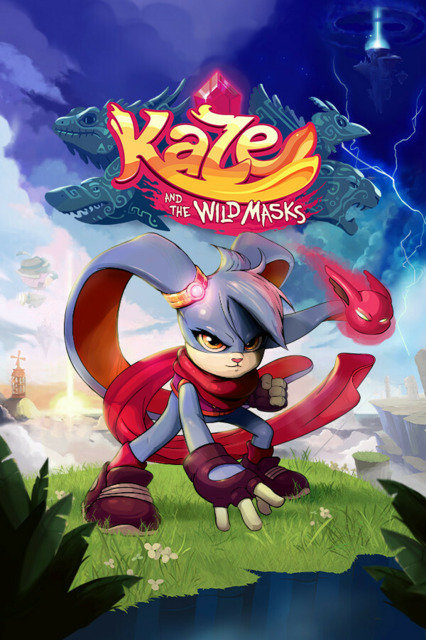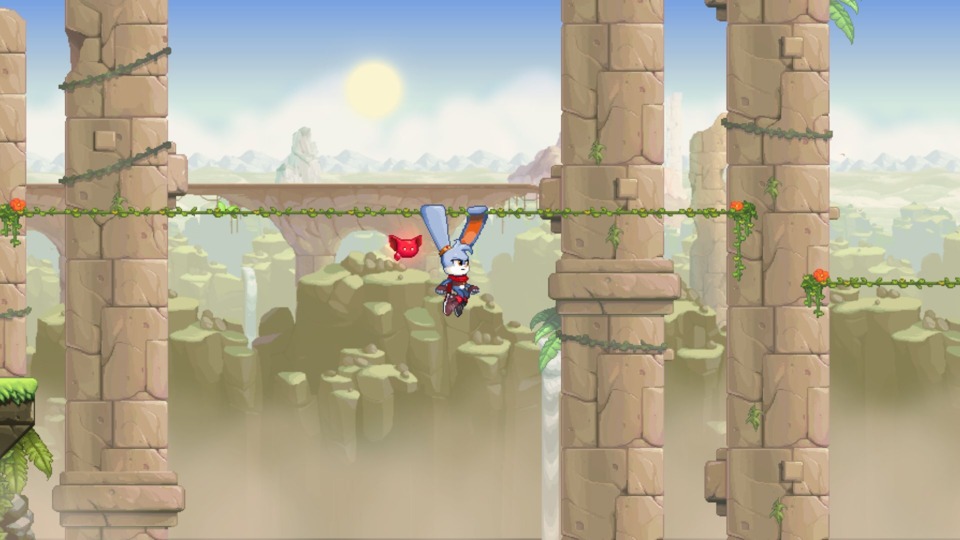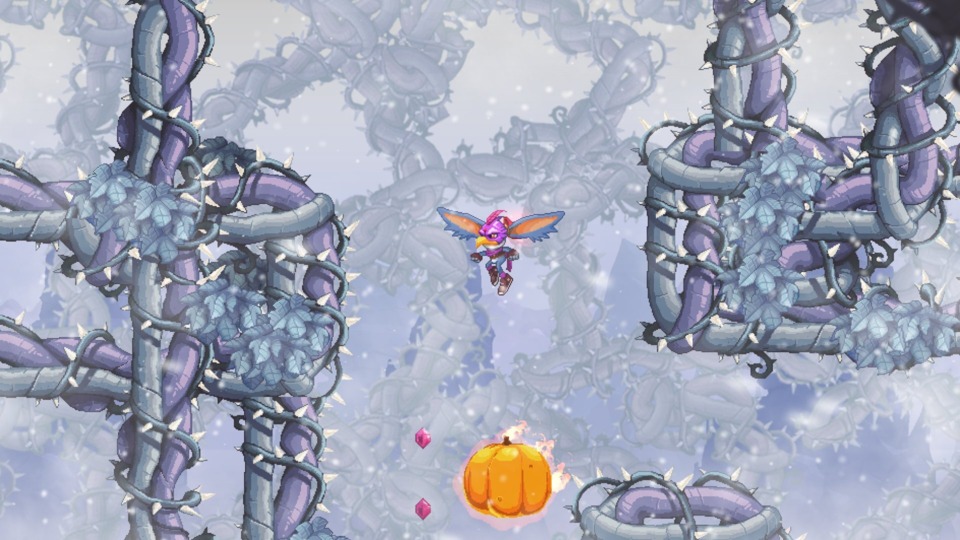Indie Game of the Week 333: Kaze and the Wild Masks
By Mento 0 Comments

Given the milestone I was so tempted to just blog about Threes this week, but who and their grandmother hasn't already played that thing to death? So instead, we're back in 2D platformer territory for an unprecedented second week for Kaze and the Wild Masks, a gorgeous platformer that carefully straddles the line between unpleasantly hard and tolerably hard. Developed by Brazilian team PixelHive, Kaze and the Wild Masks sees the eponymous leporine heroine and her friend Hogo accidentally trigger the release of a villain, Typhoon, while exploring some ruins. This also transforms Hogo into a spirit, giving Kaze double the reason to fix her own mess. The game is set across four islands each with around seven normal courses, plus a boss fight and a tougher extra level that becomes available by collecting a certain amount of post-level bonus gems. Even with a smaller than average number of levels, the game makes up for it by offering a moderately high challenge level that'll keep you busy trying to master it.
The first thing that becomes apparent when starting Kaze and the Wild Masks is how much these developers were clearly pining for a new Donkey Kong Country Returns and decided to take matters into their own hands. Kaze and the Wild Masks is unapologetically aping the ape game in both its format and its mechanics, tweaking certain elements without necessarily making any significant sweeping changes to the formula. After all, Nintendo and Retro Studios are masters of their craft, and it's never a bad idea to learn at the feet of experts when starting out. Mechanically, you can see the similarities in how Kaze moves, using her ears in a manner similar to Dixie's locks to carefully control her descent or using her attack spin while moving off platforms for a bit of extra horizontal distance before applying a mid-air jump. The other half of the DKCR connection can frequently be seen in the level design, which borrows a few ideas from the older DKC games—there's at least three levels where you're constantly trying to keep the lights on to pacify some otherwise fast-moving enemies—and collectibles like a series of letters (K.A.Z.E., this time, rather than K.O.N.G.) and some well-hidden bonus challenge areas. As it's been almost ten years since the release of Giant Bomb's "Best Music of 2014" award-winner Donkey Kong Country Returns: Tropical Freeze (albeit only five since its Switch port), I can appreciate an Indie studio having the chutzpah to take a stab at the vacated throne, especially when that studio intends—as PixelHive has done—to pour a similar amount of polish into the finished product.

Kaze and the Wild Masks removes the animal companions of the Kong clan and instead replaces them with the titular wild masks: four masks that represent a tiger, a hawk, a shark, and a lizard. Each has a different movement set and a different environment in which they shine: the hawk mask, for instance, is a necessity for mostly aerial levels that might require threading through a course lined with brambles, while the shark offers something similar for underwater courses. The tiger, meanwhile, uses an air dash and wall climbing to greatly increase its traversal ability, allowing the game to pretend it's a different platformer for a while. Finally, the lizard is possessed with a double-jump and a fast diving attack, but is unfortunately also cursed with an uncontrollable urge to run without stopping: the lizard mask courses are subsequently auto-runners, the game's closest equivalent to DKC's notorious minecart levels. As someone who could only barely tolerate the amount of auto-scrollers in the DKC/DKCR series, it was an inauspicious realization that this game had chosen to double-down on levels with either an auto-moving feature like the lizard mask or an otherwise haste-encouraging timed element such as rising levels of lava/acid or a deadly tornado chasing you from the left side of the screen. This is especially true of the fourth and last world, Carrotland, as almost every stage had some variant of this exploration-averse timed aspect. Since the game moves pretty fast already, it meant that you either had to react to hazards and enemies at the speed of thought or else keep dying until you'd memorized all the steps—the jumps, the dives, the hovers, the spins—needed to mercifully bring the level to an end. If you're anything like the collectible nut I am, feel free to double the amount of time these levels take as you try to grab everything in addition to not dying. In the end, I'm thankful the game is as short as it is; I would've been about ready to throw in the towel regardless.
Kaze and the Wild Masks does have many strong features though. The first and most obvious are the visuals, with its characters drawn and animated with a high level of detail. Kaze is an expressive protagonist as she performs her many moves, with or without a mask, and the enemies are all vegetables mutated by magic (a relatable foe for kids and picky eaters alike) to become suitably monstrous, sporting huge grimaces and shifty eyes. The level designs look great too, even if the game's not quite as adventurous as its DKCR inspiration with all of that game's silhouettes and other flights of artistic fancy, and the unambiguous, brightly-colored sprites makes it easy to pick out valuables and other points of interest in the stage while playing. If anything's obfuscated, it's those bonus area entrances and that's largely by design. It can be a little uneven with its checkpoints—most courses only have one, and it's sometimes placed early in a level for some reason—but it does give you bonus hearts that can absorb one hit and the air control for the glide is sufficient for assisting with troublesome jumps, giving the player a handful of boons in their corner. Worth noting that it won't let you glide if you bounce off an enemy; a limitation some of the later level design often uses to trip you up. The masks, too, often take some getting used to as they'll remove the default glide and switch it with something else: I was constantly trying to hit the glide in the lizard form as a force of habit, only to suddenly divebomb into the great blue yonder.

Though the game's difficulty is certainly higher than I'd prefer—though about right for a DKCR protégé—and there's far too much a preponderance for the aforementioned auto-scrollers (and also the load times are oddly long for a PS4 pixel art game), I had a great time with Kaze and the Wild Masks largely due to how slick it was for a smaller Indie platformer. That includes the variety in level formats and backdrops, the mess of collectibles to find (there's gems, which unlock a prize if you find at least 100 per level; the KAZE letters that reveal a part of the background story if you collect all four; and two halves of a green gem awarded in bonus areas that, once all have been found, reveals a possible sequel hook), the overall high quality of its presentation, and a svelte runtime that allows the game to gracefully bow out once it has exhausted all its ideas rather than reiterate them too often. I don't care for time trials or no-damage runs, but they're there as optional targets all the same (optional, that is, unless you're trying to Platinum this monster, in which case you have more balls than I do). If you're jonesing for another Donkey Kong Country game and/or much prefer rabbits over gorillas, Kaze seems like an easy recommend. Just keep in mind it's more reflex-intensive than most and to never underestimate how mean a platformer this cute can be.
Rating: 4 out of 5.
P.S.: I've included a short clip of one of the auto-runner stages to give you some idea of the accuracy required:
Kaze's first auto-runner level. Starting to think this game might be on the tough side.https://t.co/2x4xsNpsOl pic.twitter.com/VBpNK9SWaL
— Mento (@GBMento) August 18, 2023
| < Back to 332: 3000th Duel | 001-100 | 101-200 | 201-300 | > Forward to 334: Cris Tales |
